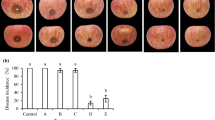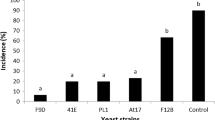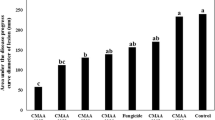Abstract
This study aimed to determine the effects of Metschnikowia pulcherrima yeast on storage quality of ‘Tainong’ mango, and elucidate it’s possible anti–disease mechanism. The results showed that M. pulcherrima could inhibit the changes in peel colour, fruit firmness, the contents of total soluble solids, total acid and vitamin C, and maintain the storage quality of mango fruits. An investigation of the mechanism showed that M. pulcherrima competed not only for the primary carbon source, but also for living space with Colletotrichum gloeosporioides. In addition, M. pulcherrima promoted the activities of defence-related enzymes, including ß-1,3-glucanase(GLU) and chitinase (CHT), and secreted a small amount of antimicrobial substances composed of volatile and nonvolatile anti-fungal compounds. The results strongly demonstrated that antagonistic yeast M. pulcherrima could be applied as a biocontrol agent for deducing the spoilage and decay of mango fruit.






Similar content being viewed by others
References
Mahunu M, Zhang HY, Yang QY, Zhang XY, Li DD, Zhou YX. Improving the biocontrol efficacy of Pichia caribbica with phytic acid against postharvest blue mold and natural decay in apples. Biol. Control. 92:172–180 (2016).
Zhang HY, Ma LC, Jiang S. SaLicylic acid enhances biocontrol efficacy of Rhodotorula glutinis against postharvest Rhizopus rot of strawberries and the possible mechanisms involved. Int. J. Food Microbiol. 141: 122–125 (2010).
Zhu RY, Lu LF, Lu HP. Postharvest control of green moLd decay of citrus fruit using combined treatment with sodium bicarbonate and Rhodosporidium paludigenum. Food Biopro. Technol. 6: 2925–2930 (2013).
Bautista-Rosales PU, Calderon-Santoyo M, Servín-Villegas R, Ochoa-Álvarez NA, Ragazzo-Sánchez JA. Action mechanisms of the yeast Meyerozyma caribbica for the control of the phytopathogen Colletotrichum gloeosporioides in mangoes. Biol. Control 65:293–301 (2013).
Jat BL, Sharma P, Gour HN. Production of Enzymes and Culture Filtrates by Colletotrichum gloeosporioides Penz. Causing Banana Fruit Rot. Production of Enzymes and Culture Filtrates 83:177–180 (2013).
Campos-Martínez A,Velazquez-del Valle MG, Flores-Moctezuma HE, Suarez-Rodríguez R, Ramírez-TrujiLLo JA, Hernandez-Lauzardo AN. Antagonistic yeasts with potential to control Colletotrichum gloeosporioides (Penz.) Penz. and Sacc. and Colletotrichum acutatum J.H. Simmonds on avocado fruits. Crop Prot. 89: 101–104 (2016).
Guo J, Fang WW, Lu HP, Zhu RY, Lu LF, Zheng XD, Yu T. Inhibition of green mold disease in mandarins by preventive applications of methyl jasmonate and antagonistic yeast Cryptococcus Laurentii. Postha. Biol. Technol. 88:72–78 (2014).
Grzegorczyk M, Żarowska B, Restuccia C, Cirvilleri G. Postharvest biocontrol ability of killer yeasts against Monilinia fructigena and Monilinia fructicola on stone fruit. Food Microbiol. 61: 93–101 (2017).
Tang JM, Liu YQ, Li HH, Wang LM, Huang K, Chen ZX. Combining an antagonistic yeast with harpin treatment to control postharvest decay of kiwifruit. Biol. Control 89: 61–67 (2015).
Ponsone ML, Nally MC, Chiotta ML, Combina M, KöhL J, Chulze SN. Evaluation of the effectiveness of potential biocontrol yeasts against black sur rot and ochratoxin A occurring under greenhouse and field grape production conditions. Biol. Control 103: 78–85 (2016).
Graeme M, Walke R, Anne H, Mcleod Valerie J, Hodgson K. Interactions between killer yeasts and pathogenic fungi. FEMS Micro. Lett. 127: 213–222 (1995).
Tian SP, Fan Q, Xu Y, Jiang AL. Effects of caLcium on biocontrol activity of yeast antagonists against the postharvest fungal pathogen Rhizopus stolonifer. Plant Pathol. 51: 352–358 (2002).
Usall J, Torres R, Teixido N. Biological control of postharvest diseases on fruit: a suitable alternative. Curr. Opin Food Sci. 11: 51–55 (2016).
Jamalizadeh M, Etebarian HR, Aminian H, Alizadeh A. A review of mechanisms of action of biological control organisms against post-harvest fruit spoilage. EPPO Bull 41: 65–71 (2011).
Bautista-Rosales PU, CaLderon-Santoyo M, Servín-Villegas R, Ochoa-Álvarez NA, Ragazzo-Sánchez JA. Biocontrol action mechanisms of Cryptococcus Laurentii on Colletotrichum gloeosporioides of mango. Crop Prot. 65:194–201 (2014).
Chi MS, Li GK, Liu YS, Liu GQ, Li M, Zhang XJ, Sun ZQ, Sui Y, Liu J. Increase in antioxidant enzyme activity, stress tolerance and biocontrol efficacy of Pichia kudriavzevii with the transition from a yeast-like to biofilm morphology. Biol. Control 90: 113–119 (2015).
Jin P, Zheng C, Huang YP, Wang XL, Luo ZS, Zheng YH. Hot air treatment activates defense responses and induces resistance against Botrytis cinerea in strawberry fruit. J. Integ. Agric. 15: 2658–2665 (2016).
Kwon MJ, Wei N, Millerick K, Popovic J, Finneran K. Clostridium geopurificans strain MJ1 sp. nov., a strictly anaerobic bacterium that grows via fermentation and reduces the cyclic nitramine explosive hexahydro-1,3,5-trinitro-1,3,5-triazine (RDX). Curr. Microbiol. 68: 743–750 (2014).
Hartman GL, Pawlowski ML, Chang HX, Hill CB. Successful Technologies and Approaches Used to Develop and Manage resistance against Crop disease and Pests. Emerging Technologies for Promoting Food Security. 8: 43–66 (2016).
Parafati L, Vitale A, Restuccia C, Cirvilleri G. Biocontrol ability and action mechanism of food-isolated yeast strains against Botrytis cinerea causing postharvest bunch rot of table grape. Food Microbiol. 47:85–92. (2015).
Chan,Z.L. and Tian, S.P. Interaction of antagonistic yeast against postharvest pathogens of apple fruit and possible mode of action. Postha. Biol. Technol., 36, 215–223. (2005).
Spadaro, D. and Droby, S. (2016). Development of biocontrol products for postharvest diseases of fruit, The importance of elucidating the mechanisms of action of yeast Antagonists. Tre. Food Sci. Technol., 47, 39–49.
Luo SS, Wan B, Feng SH, ShaoYZ. BiocontroL of Postharvest Anthracnose of Mango Fruit with Debaryomyces Nepalensis and Effects on Storage Quality and Postharvest physiology. J. Food Sci. 80: 2555–2563 (2015).
Shao YZ, Xie JH, Chen P, Li W. Changes in some chemical components and in the physiology of rambutan fruit (Nephelium lappaceum L.) as affected by storage temperature and packing material. Fruits 68 (1): 15–24 (2013).
Ippolito A, Ghaouth AE, Wilson CL, Wisniewski M. Control of postharvest decay of apple fruit with Candida saitoana and induction of defense responses. Phytopathol. 93: 344–348 (2003).
Wirth SJ, Wolf GA. Dye-Labelled substrates for the assay and detection of chitinase and lysozyme activity. J. Micro. Meth. 11: 197–205 (1990).
Mackie AE, Wheatley RE. Effects and incidence of volatile organic compound interactions between soil bacterial and fungal isoLates. Soil Biol. Biochem. 31(3): 375–385 (1999).
Sharma RR, Singh D, Singh R. Biological control of postharvest diseases offruits and vegetables by microbial antagonists: a review. Biol. Control 50:205–221 (2009).
Spadaro D, Ciavorella A, Zhang D, Garibaldi A, Gullino ML. Effect of culture media and pH on the biomass production and biocontrol efficacy of a M. pulcherrimastrain to be used a fungicide for postharvest disease control. Can. J. Microbiol. 56: 128–137 (2010).
Keshavarz-Tohid V, Taheri P, Taghavi SM, Tarighi S. The role of nitric oxide in basal and induced resistance in relation with hydrogen peroxide and antioxidant enzymes. J. Plant Physiol. 199: 29–38 (2016).
Ferraz LP, da Cunha T, da Silva AC, Kupper KC. Biocontrol ability and putative mode of action of yeasts against Geotrichum citri-aurantii in citrus fruit. Microbiol. Res. 188: 72–79 (2016).
Esposito-Polesi NP, de Abreu-Tarazi MF, de ALmeida CV, de Almeida ML. Investigation of Endophytic Bacterial Community in Supposedly Axenic Cultures of Pineapple and Orchids with Evidence on Abundant Intracellular Bacteria. Curr. Microbiol. 74: 103–113 (2017).
Yang JL, Sun C, Zhang YY, Fu D, Zheng KD, Yu T. Induced resistance in tomato fruit by c-aminobutyric acid for the control of aLternaria rot caused by Alternaria alternate. Food Chem. 221: 1014–1020 (2017).
Zhang ZK, Yang DQ, Yang B, Gao ZY, Li M, Jiang YM, Hu MJ. ß-Aminobutyric acid induces resistance of mango fruit to postharvest anthracnose caused by Colletotrichum gloeosporioides and enhances activity of fruit defense mechanisms. Sci. Horti. 160: 78–84 (2013).
Roberti R, Veronesi A, Cesari A, Cascone A, Di Berardino I, Bertini L, Caruso C. Induction of PR proteins and resistance by the biocontrol agent Clonostachys rosea in wheat plants infected with Fusarium culmorum. Plant Sci. 175: 339–347 (2008).
Da Silva Felix K, da Silva CL, de Oliveira WJ, de Lima Ramos Mariano R, de Souza EB. Calcium-mediated reduction of soft rot disease in Chinese cabbage. Europ. J. Plant Pathol. 147:73–84 (2017) DOI: 10.1007/s10658-016-0980-0.
Kumar PS,Duraipandiyan V,Ignacimuthu S.Isolation,screening and partial purification of antimicrobial antibiotics from soil Streptomyces sp. SCA 7.Kaohsiungd MedSci. 30: 435–446 (2014).
Kai M,Effmert U,Berg G, Piechulla B.Volatiles ofbacterial antagonists inhibit mycelial growth of the plant pathogen Rhizoctonia solani.Arch Microbiol. 187: 351–360 (2007).
Theis T, Stahl U. Antifungal proteins, targets, mechanisms and prospective applications. Cellu Mole. Life Sci. Cmls. 61: 437–455 (2004).
Castoria R, Curtis FD, Lima G, Cicco VD. ß-1,3-glucanase activity of two saprophytic yeasts and possible mode of action as biocontrol agents against postharvest diseases. Postha. Biol. Techno. 12: 293–300 (1997).
Acknowledgements
This work was funded by the Project of the National Natural Science Foundation of China (No. 31660587), and it represents part of work for the project of the Key Research and Development of Science and Technology Department in Hainan Province (ZDYF2016043).
Author information
Authors and Affiliations
Corresponding authors
Ethics declarations
Conflict of interest
The authors declare that they have no conflict of interest.
Rights and permissions
About this article
Cite this article
Tian, Yq., Li, W., Jiang, Zt. et al. The preservation effect of Metschnikowia pulcherrima yeast on anthracnose of postharvest mango fruits and the possible mechanism. Food Sci Biotechnol 27, 95–105 (2018). https://doi.org/10.1007/s10068-017-0213-0
Received:
Revised:
Accepted:
Published:
Issue Date:
DOI: https://doi.org/10.1007/s10068-017-0213-0




